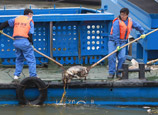
Closed-loop recycling, in which plastics waste is used to make another product, thus carries significant environmental benefits, such as reduced energy and oil consumption.
But the process of separating the petroleum-based recyclable plastics from other kinds of plastics and solid waste is difficult, costly, and labor-intensive, so only a small proportion is recycled.
In 1988, the United States Society of Plastics Industry (SPI) developed a coding system in which each kind of resin is labeled with a number, 1-7, to facilitate sorting. The system has also been used elsewhere, including in Canada and Switzerland, but has not been adopted worldwide and is still confusing to some consumers.
If consumers knew to collect and separate household plastics based on their number, the resulting boost to recycling efforts would demonstrate to government and industry the viability of a more sustainable approach, reduce exposure to rising oil prices, and support growing global demand for plastics.
Plastics recycling
There are four categories of plastics recycling: primary recycling, in which the plastic is re-used in the same application; secondary recycling, in which material (mixed or contaminated) is used in less demanding applications; tertiary recycling, in which the plastic is converted into monomers or chemicals; and quaternary recycling, in which only energy is recovered through incineration.
Each of these methods recovers a different amount of the embodied energy of the plastic item. (All of the embodied energy is lost if the plastics are land-filled, a common disposal method worldwide.)


















 What house can you buy with 1 million yuan in China?
What house can you buy with 1 million yuan in China?


![]()
